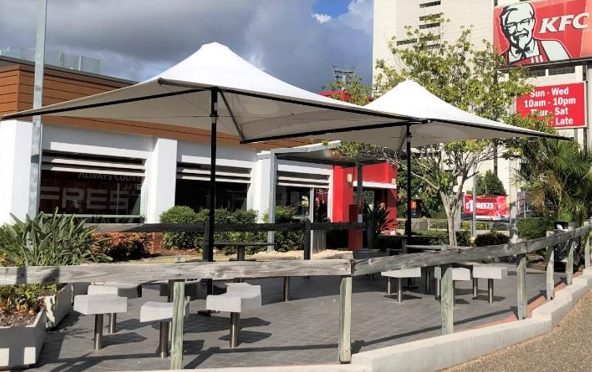YOU ARE HERE:

Exploring the Price of Waterproof Shade Structures
Jamie Howard In Uncategorized, Shade Structure
When it comes to creating comfortable and stylish outdoor spaces, shade structures are essential. They provide respite from the scorching sun, protect against harmful UV rays, and offer a sense of serenity. However, one common query that arises among homeowners and businesses alike is the cost associated with waterproof shade structures. Are they worth the investment? In this article, we will delve into the factors that make waterproof shade structures more expensive and discuss whether they are superior to their non-waterproof counterparts.
Is a Waterproof Shade Sail Better?
To determine if waterproof shade sails are better, we must first understand the advantages they offer. Waterproof shade sails provide protection not only from the sun but also from rain, making them an all-weather solution for outdoor spaces. They are particularly beneficial in regions with unpredictable weather patterns, ensuring that your outdoor area remains usable even during a sudden downpour.
Furthermore, waterproof shade sails are often made from high-quality materials that are more durable and resistant to wear and tear. This longevity can save you money in the long run, as you won’t need to replace or repair your shade structure as frequently as you might with a non-waterproof option.
Additionally, the waterproofing feature enhances the versatility of the shade sail. It can be used for various purposes, such as creating an outdoor dining area, protecting valuable outdoor furniture, or even covering a hot tub or pool. This multifunctionality can add value to your property and enhance your outdoor lifestyle.
Why Are Shade Sails So Expensive?
The cost of shade sails, whether waterproof or not, can be a significant investment. Several factors contribute to the expense of these structures:
Material Quality: The quality of materials used in shade sails plays a pivotal role in their cost. Waterproof shade sails are typically constructed from premium materials, such as high-density polyethylene (HDPE) fabric, that are designed to withstand harsh weather conditions. These materials are more expensive than standard shade cloth, which is often used in non-waterproof shade sails.
Design and Customization: The design and customization of shade sails can greatly affect their cost. Complex and unique designs, as well as customized sizes, require more labour and resources, leading to higher prices. Waterproof shade sails are often custom designed to ensure a proper fit and maximum protection, which can increase their cost compared to off-the-shelf options.
Engineering and Installation: Proper installation is essential for the longevity and effectiveness of shade sails. Waterproof shade sails may require additional engineering and hardware to ensure they can withstand heavy rainfall and wind. This added complexity in installation contributes to the overall expense.
Waterproofing Technology: The process of waterproofing shade sail fabric involves advanced technologies and treatments that make the material impermeable to water. These technologies add to the cost of production.
Warranty and Durability: Manufacturers of waterproof shade sails often offer extended warranties due to the higher durability of the materials used. These warranties provide peace of mind but can also raise the upfront cost.
What Is Waterproof Shade?
A waterproof shade, as the name suggests, is a shading structure designed to keep rainwater from passing through its material. It effectively repels water, ensuring that the space beneath it remains dry and comfortable. Waterproof shades come in various forms, including umbrellas, canopies, and sails. Among these, waterproof shade sails are becoming increasingly popular due to their modern aesthetic and versatility.
Waterproof shade sails are typically made from HDPE fabric that has been treated to resist water penetration. This treatment, along with the design and installation, ensures that rainwater rolls off the surface, preventing it from dripping through and soaking the area below.
The Disadvantages of Shade Sails
While shade sails offer numerous benefits, it’s essential to consider their disadvantages as well:
Limited UV Protection: While shade sails provide shade and reduce UV exposure, they may not offer complete protection from all angles. This means that certain areas under the sail may still be exposed to harmful UV rays.
Aesthetic Preferences: The unique design of shade sails may not appeal to everyone. Some individuals may prefer a more traditional or streamlined look for their outdoor spaces, and shade sails may not align with their aesthetic preferences.
Maintenance: Shade sails require regular maintenance to ensure their longevity. This includes cleaning, tightening, and occasional re-tensioning to keep them looking and performing their best.
Cost: As discussed earlier, the initial cost of shade sails, especially custom and waterproof options, can be relatively high. This can deter some homeowners from investing in them.
Conclusion
Waterproof shade structures, particularly shade sails, offer a range of advantages, making them a valuable addition to outdoor spaces. They provide protection from both the sun and rain, enhancing usability and comfort. However, their higher cost can be a deterrent for some. It’s essential to consider the quality, customization, and durability when evaluating the expense of waterproof shade structures.
Ultimately, whether a waterproof shade structure is worth the investment depends on your specific needs, budget, and aesthetic preferences. If you live in an area with unpredictable weather and want a versatile outdoor space, a waterproof shade sail may be an excellent choice. It is also critical to choose a supplier and installer that can make your vision a reality like the multi award winner Versatile Structures
Share:
Jamie Howard - Director
Co-founder and Director Jamie has been hands-on in the shade and steel industry since leaving school. With over 15 years’ experience in shade, membrane and steel projects, Jamie is excited about the design opportunities shade structures offer in the commercial and industrial sectors. Jamie’s extensive design skills give him a competitive edge in situations with technical design complexity. He has won two personal industry awards for his designs, alongside many company-won awards.

